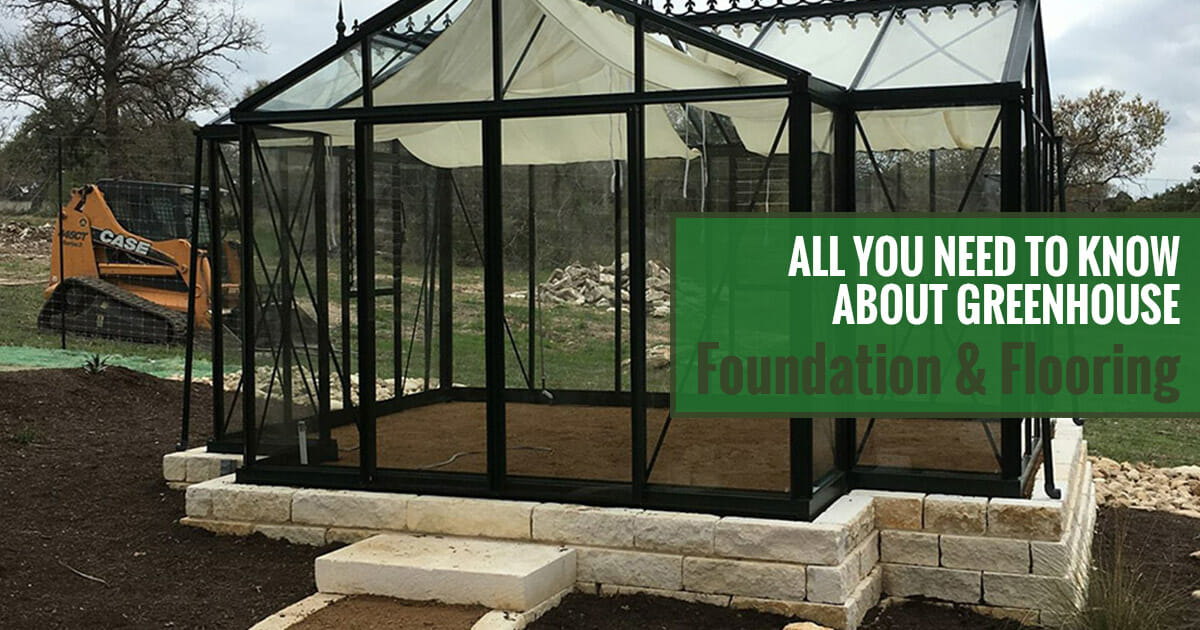You can’t have a strong building without a strong foundation, and a greenhouse is no exception. If you want your greenhouse to weather any storms that come its way, it’s important not to overlook this crucial element. But no matter whether you live in a mild or stormy climate, a foundation is essential to ensuring that your greenhouse remains upright in the long run.
But unlike a house, a greenhouse is a relatively simple structure, and as such it doesn’t require an overly complicated foundation. Still, there are several different types of foundations to choose from, including stem walls, footings, and slabs. Which one is best for you depends on the weight and size of your greenhouse, location, soil type, zoning requirements, budget, and preferences.
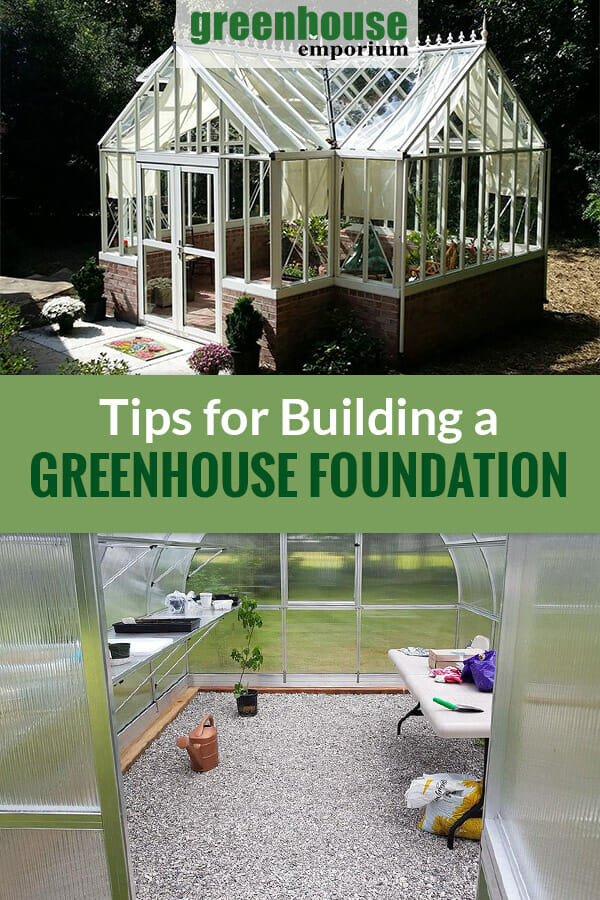
By giving some thought to the type of foundation and flooring of your new greenhouse before you start installing it, you’re setting yourself up for success. Read on to learn all you need to know about greenhouse foundations and flooring!
Why you shouldn’t overlook the importance of a great foundation
We often get asked whether it’s necessary to build a foundation for a greenhouse. The short answer is: yes, all greenhouses need a foundation. While we recognize that it may seem like an unnecessary step, we promise you that it will be worth it in the long run.
But what exactly makes a foundation great? The best foundations are those that are constructed from strong materials (such as concrete, wood, or bricks) and are level. A level foundation is key, because it ensures that the greenhouse can be properly assembled, and it prevents cracking, bending, or warping down the line.
Here are further reasons why foundations matter:
Stability: Whether you are constructing your own greenhouse or assembling a greenhouse kit, a solid foundation will ensure the strength and stability of the greenhouse. Even the most well-designed greenhouse won’t hold up in stormy weather or during an earthquake if it isn’t firmly attached to a secure, level foundation.
Durability: Greenhouse kits are designed to be built on a level site and will last longest when set up accordingly. Additionally, a good, durable foundation such as a concrete foundation will increase the lifespan of a greenhouse by helping it resist settling and shifting over time.
Assembly: Greenhouse kits are manufactured true and square, and won’t assemble properly if placed on an uneven foundation. Assembly will go much smoother if the foundation is already laid and properly leveled.
Permanence: If you do it right the first time, you won’t have to renew the foundation for a long time, increasing the permanence of your greenhouse.
Cleanliness: A proper foundation has good drainage, which prevents water puddles and reduces the presence of algae, pests, diseases, and weeds inside your greenhouse. Additionally, a concrete, paved, or wooden floor allows easy cleanup of spilled soil.
Types of greenhouse foundations
What kind of foundation do you picture when you think of a greenhouse? Do you imagine a raised wall, also known as a stem wall? Or do you imagine a beautiful wooden deck? Or perhaps a concrete slab with room for an outdoor patio? The truth is, there are so many greenhouse foundation options.
What’s best for your greenhouse depends on several factors, including the type, size, and weight of your greenhouse, location, soil conditions, zoning requirements, budget, and preferences. For example, you might prefer the aesthetics of a brick footer. Or, if you are installing a glass greenhouse, you may need a stronger foundation such as a concrete pad or footer.
Let’s take a closer look at the different kinds of foundations:
Footings, perimeter walls, and stem walls
If you want a foundation that does the job but doesn’t cost a fortune, then a footing, perimeter wall, or stem wall may be the way to go. These simple foundations follow the outline or perimeter of the greenhouse, but are not completely filled in the way a slab would be. The greenhouse frame is then attached directly to the foundation.
As with any foundation, the outline has to be level to ensure a square greenhouse, and is usually anchored into the ground with rebar or stakes. The most common materials used in footings, perimeter walls, and stem walls include wood and concrete, but brick, stone, and cinder blocks can also be used.
Wooden perimeter wall
This is what we usually recommend for hobby greenhouses, as it is the simplest and least expensive way to create a level foundation wall. The wood frame can be made using several layers of 2×4 or one layer of 4×4 or 6×6 wood timber.
Pressure-treated lumber is a popular choice for wooden greenhouse foundations, as it is slow to rot even when touching wet soil. However, if you plan to grow directly in the soil, you may want to pick an untreated hardwood such as cedar or redwood instead, so as to avoid any chemicals leaching out into your soil.

If you’re wondering whether this wood foundation is secure enough to weather storms or high winds, there are a few ways you can anchor the wooden perimeter foundation to the ground. Some greenhouse kits come with ground anchors already, or you can use rebar stakes, cast concrete posts, or set the foundation frame into a trench at least 2-4 inches deep.
Concrete footing
A concrete footing is similar to a wooden perimeter wall, but stronger and more permanent. Though it’s usually more expensive, it does provide more security which may make it worth it if you live in a particularly stormy climate.
For any type of concrete greenhouse base, it’s best to hire a professional to pour the concrete; they will be able to make sure the concrete maintains its strength, sets correctly, and is perfectly level. You may be able to save some costs if you are building your greenhouse at the same time as a house or new driveway.
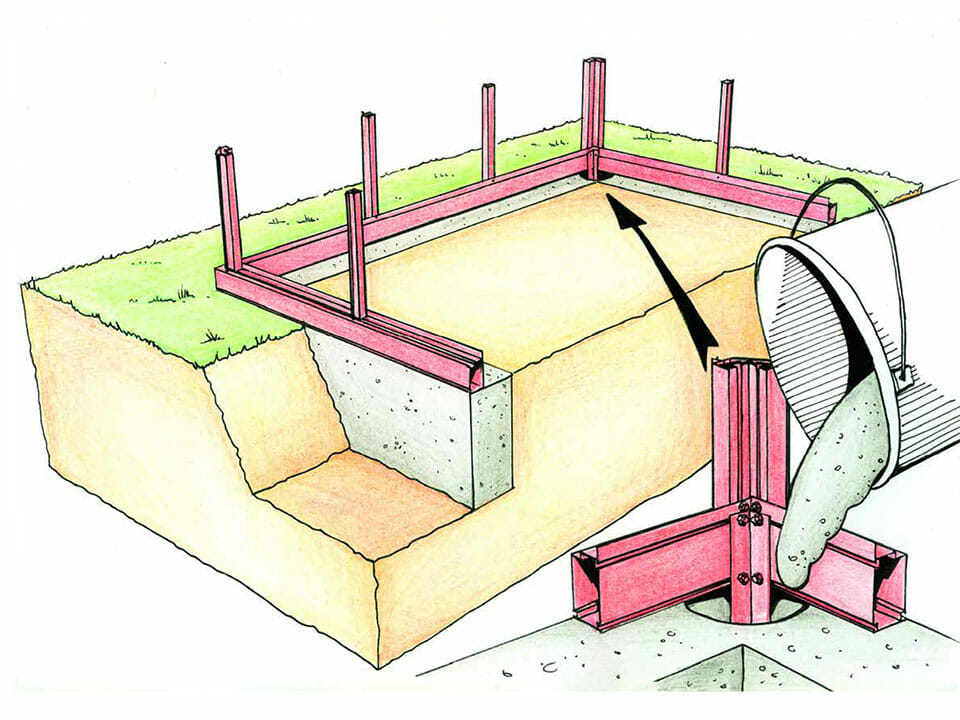
A concrete footing should work with most greenhouse kits, but make sure to check with the manufacturer before deciding to go this route, as once concrete is poured it is more or less permanent!
Brick or cinder block footing
If you prefer a more “rustic” aesthetic, you might use bricks or cinder blocks to build a greenhouse footing. This might be a good choice for heavier glass greenhouses, which require a strong foundation. You can also match any bricks, retaining walls, or other things from your garden design.
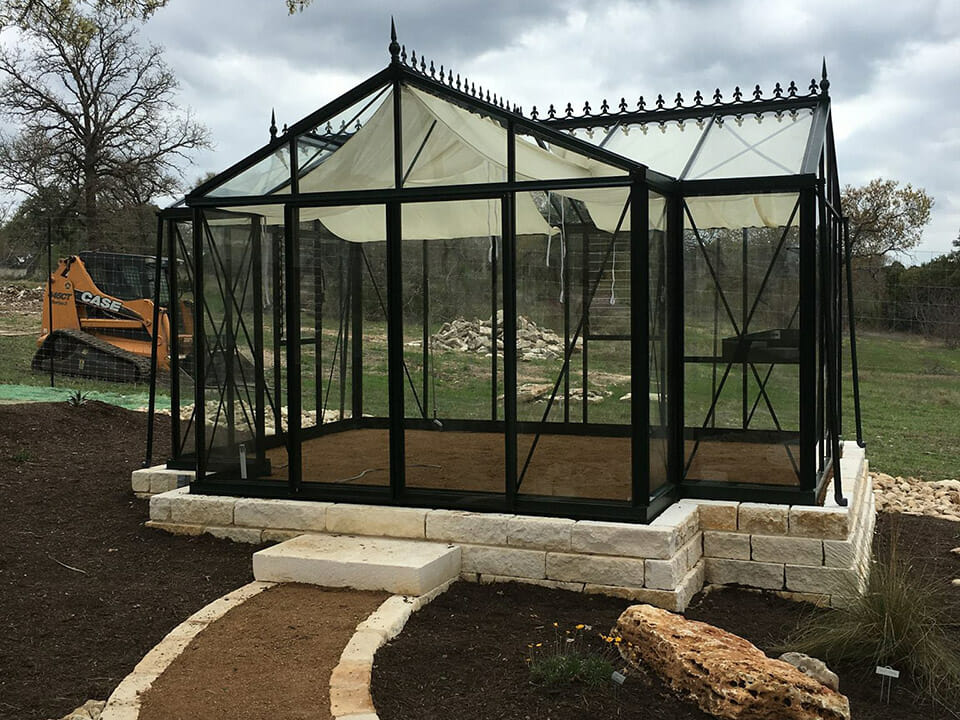
As with the other types of foundations, make sure that the bricks are stacked so they are level!
Stem walls
Raised walls or stem walls are a beautiful way to lift a greenhouse off of ground level by more than a couple inches (usually about 1-2 feet). As a result, there’s more headroom in the greenhouse, which can be great to make small greenhouses feel more spacious. Keep in mind, however, that increasing the interior area will make it harder to keep the greenhouse warm in winter, if that is something you want to do.
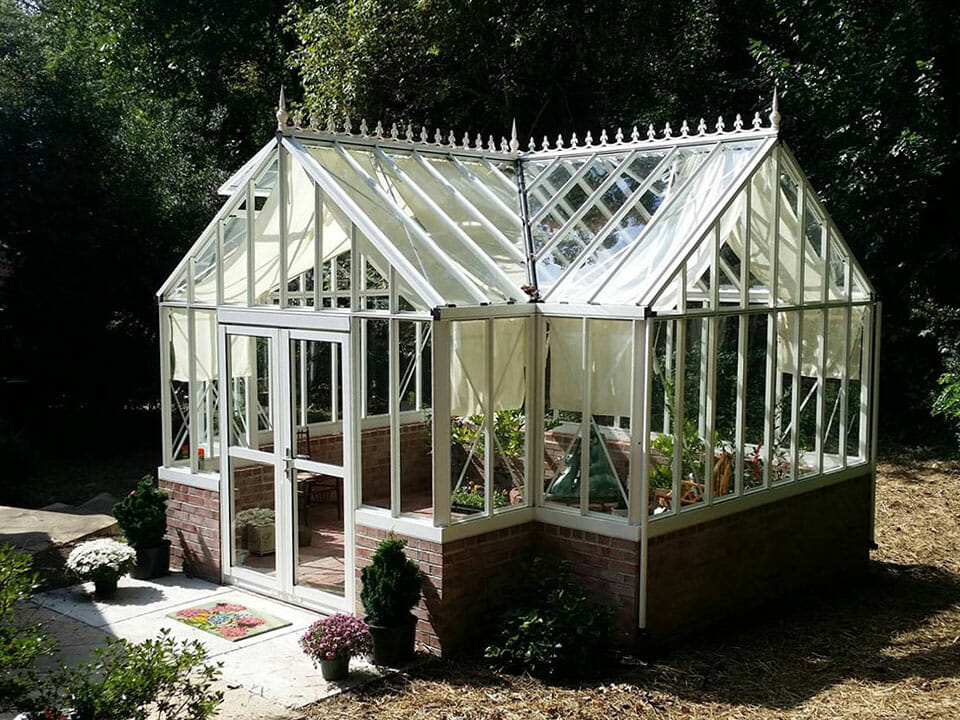
Stem walls are not compatible with all greenhouse kits. Since the greenhouse is lifted up, the door has to be dropped down to ground level. Some kits, like the Royal Victorian Greenhouse by Exaco, offer the option of a drop door.
Slabs, decks, and pads
When we say “slab,” “pad,” or even “deck,” we mean a full foundation that is not just the outline of the greenhouse, but the entire footprint. A slab foundation is usually built using concrete, stone, brick, or wood. It creates an even surface to walk on and with proper drainage should remain dry and easy to clean.
Compacted soil foundation
A compacted soil foundation is the most basic type of greenhouse base that involves tamping down the earth until it is level and solid. This foundation works well for greenhouse kits with base frames or anchors that can’t be lifted up off the ground and are instead designed to be anchored directly into the soil. However, just as with other foundations it is important that the ground is level.
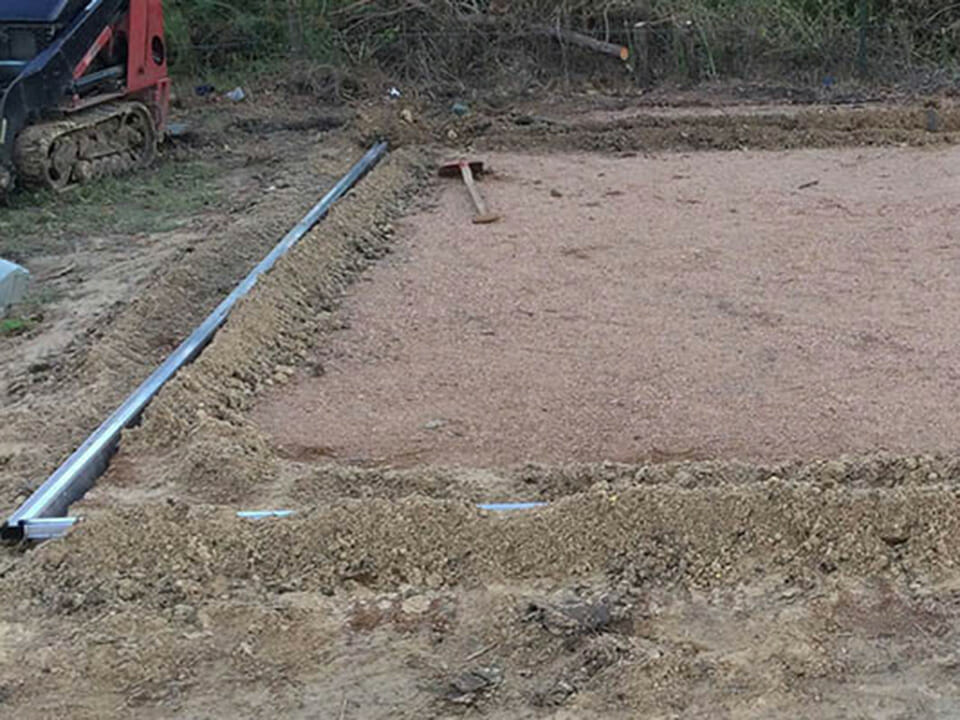
This is not the strongest foundation but it will surely save you money. It is best for temporary greenhouses or those that are smaller than 8ft x 10ft. The weight of bigger greenhouses may cause glass breakage or warping of frames.
Soil foundations are more difficult to level and keep level, unlike concrete. Yes, it will definitely save you more money but will cost you more time to maintain in the long run.
Despite those disadvantages, many hobby greenhouse gardeners prefer soil foundations because they allow you to grow directly into the soil. If you plan to go this route, make sure to read the section about greenhouse flooring, as you’ll want to at least have some kind of path installed to prevent a muddy mess.
Concrete slab or pad
A lot of people think that concrete slabs are the best choice for greenhouse foundations, but that’s not necessarily the case. Though a concrete slab is the most secure type of foundation for a greenhouse, it is expensive to install and requires some plumbing to ensure proper drainage.
However, a solid concrete base may be a good choice for a larger greenhouse, or one that will be used as a place of relaxation in addition to growing or seed starting. One additional benefit of a concrete slab foundation is that it acts as a heat sink in winter, absorbing heat during the day and slowly releasing it at night, which can help to even out temperatures and keep your greenhouse warm.
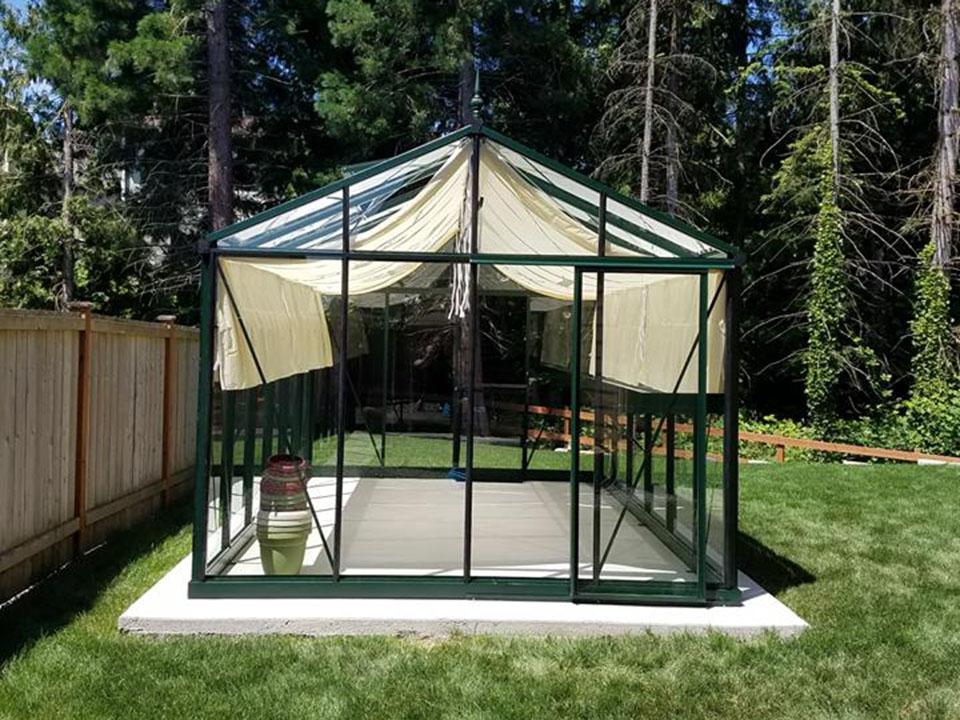
Note that concrete slabs are often considered “permanent structures” and may require special building permits, depending on your county and/or HOA. Make sure to check with all the necessary entities before going this route!
Wooden deck
A wooden deck can be built as the foundation for your greenhouse, and can be a very beautiful option. Plus, it is easy to clean and drains well, thanks to the space between timbers. When you want to increase the humidity in your greenhouse, you can simply sprinkle some water on the floor!
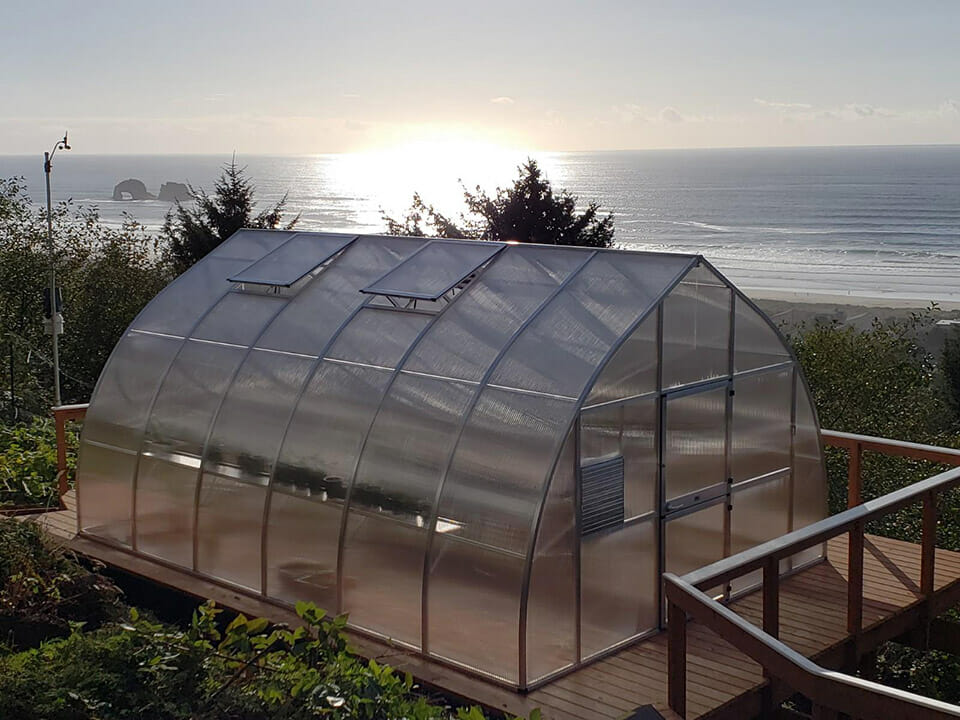
However, an important consideration to keep in mind is that a wooden deck doesn’t provide much insulation against extreme heat or cold, making it more difficult to control the temperature inside.
Stone or brick paved foundation
If you want to use stone or bricks to match your garden paths, you can create a paved foundation using stone or bricks. This type of foundation, in addition to being beautiful, offers excellent drainage and easy cleanup.

When constructed properly, a paved foundation can help insulate against the cold in winter, and even act as a natural heat sink, absorbing heat from the sun during the day and releasing it at night, when temperatures drop.
Greenhouse foundation
If you decide to forego a full slab, deck, or pad foundation, it’s a good idea to give some thought to adding flooring inside of your greenhouse.
The benefits of adding flooring in your greenhouse
If you plan on growing primarily in containers or raised beds, you can install almost any flooring. Popular choices include pea gravel, flooring tiles, bricks, wooden pallets, wood chips, stones, and more. In addition to creating a cleaner, mud-free space, flooring elevates the look of your greenhouse and, depending on the type of material, adds insulation against the winter cold.
Types of greenhouse flooring
No matter which material you go with, we recommend installing a weed barrier below the flooring, such as this Polypropylene ground cover. Alternatively, you can lay down overlapping cardboard as a natural weed barrier, just note that this method may need to be redone after a few seasons.
Gravel
A gravel floor is what we usually recommend. It’s clean, easy to source, somewhat easy to level, and it drains well. The type of gravel you should choose depends on what you have available locally and your budget. Most people go for pea gravel, though crushed stone and river rock can work as well.
Flooring tiles
For more security and less mess, you can add some flooring tiles or pavers where you would walk and work the most. This may keep your greenhouse nice and clean. You can use rock tiles or pre-manufactured lockable flooring tiles, such as these. Besides the surefootedness, they also allow water to drain quickly.
Other options
Though we recommend adding a layer of gravel or flooring tiles inside your greenhouse for best results, below are some different options you might consider. Keep in mind that some of these may need to be replaced more quickly over time, especially if they are prone to holding in excess water, which can create a breeding ground for algae.
- Bricks
- Heavy landscape fabric
- Flat rocks
- Old rugs or carpet
- Wood from pallets
- Wood chips
Tips for BEFORE you build your greenhouse foundation and flooring
There are a couple of things you should check before you start building your greenhouse foundation:
1. Check your building codes
First, check with your district and HOA if you need a permit for your project. There are also zoning requirements that limit the kinds of foundations you can build and how. Make sure you have all the necessary paperwork BEFORE you start building to avoid any hangups!
If you’re digging into the ground with heavy equipment, call your city (dial 811) to have them mark the utility lines on your property.
2. Wait for your greenhouse to arrive
Although you can get exact greenhouse measurements from us or the manufacturer, we recommend waiting until you receive the greenhouse before constructing your foundation to ensure that everything is correct. This is especially important with concrete foundations, which are more or less permanent!
3. Pick the right location
Make sure to select a location that is free from nearby obstacles and receives plenty of sunlight. If possible, you want to select a spot that is somewhat wind protected; not only will this make assembly easier, but it will reduce the wind load on your greenhouse, protecting it in the long run.
4. Examine the ground
Make sure to examine your chosen location’s soil, especially if you are going with a compacted soil foundation. Are there a lot of rocks that will make it difficult to level it? Is it particularly soft, wet, or unstable? Select a new site if you think the soil won’t be able to support your chosen foundation.

